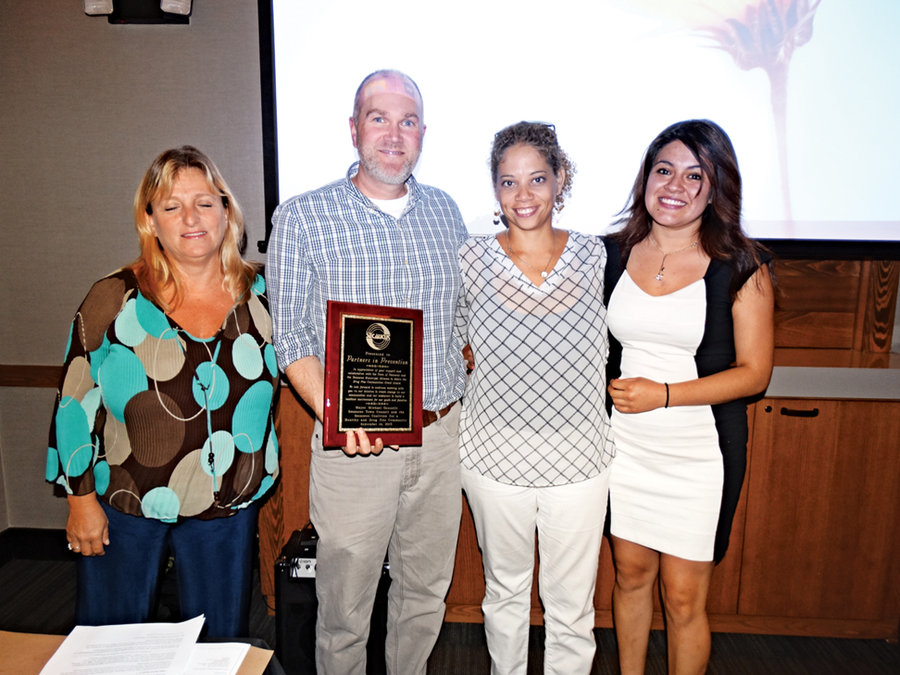The Secaucus Coalition for a Healthy and Drug Free Community is one year old. The group marked its anniversary with an “End of the Year Celebration” on Sept. 26 at Bonefish Grill.
Many of the key contributors to the coalition were honored or thanked throughout the evening, with guest speakers providing a look back at the past year and a look ahead at the next.
“Our mission is to reduce the negative impacts of alcohol and prescription drug abuse in our community and allow our youth to make healthier lifestyle choices where they can achieve their goals and be successful in the future,” said Coalition Director Tania Guaman. “We are taking care of the generations that are going to be our future and we want to make sure that the environment is the best it can be.”
The group meets every third Wednesday of the month at the Community Center. Coalition “members” consist of anybody who has helped out or supported the group over the course of the past year.
“A coalition member is basically anyone who has participated in any way, shape, or form in support of drug and alcohol prevention,” said Guaman. “A coalition member doesn’t mean they have to show up to every single meeting. It just means that they have made some kind of contribution, be it spoken word, connecting us to someone, or sharing an email with information. People have different levels of commitment so we try to be as open as we can about how people want to be involved. That’s how we get a good result.”
The year-end event was designed to recognize and celebrate those contributions and thank those participants.
History of prevention
The coalition grew out of the Secaucus Municipal Alliance, headed for more than ten years by Jill Preiss, one of the people honored at the event. “Our mission was to promote drug and alcohol abuse prevention among the youth of Secaucus,” said Preiss.
The Municipal Alliance was funded by a small state grant. Several years ago Secaucus applied for a federal Drug Free Communities Program grant from the Substance Abuse and Mental Health Administration (SAMHSA). The initial application was denied by one point.
With the help of Partners in Prevention, a county organization in existence since 1988, the grant application was rewritten and submitted, and this time it was approved, providing Secaucus with $125,000 per year for five years, with a potential to extend to 10 years.
“Our mission is to reduce the negative impacts of alcohol and prescription drug abuse in our community.” –Tania Guaman
____________
Pam Capaci came on board this past January as coalition director.
“I’m really just a behind-the-scenes person providing training and support,” said Capaci, who has been involved in the field for 25 years. “I’m here to make sure that we’re complying with all of our grant requirements in a timely way. This is a five-year grant and then it’s renewable for another five years, so we want to get a great foundation.”
Oct. 1 marked the beginning of the second year of the grant.
Taking care of our future
In addition to a presentation by Capaci on the benefits, characteristics, costs, and stages of development for coalitions, the evening included a PowerPoint presentation by guest speaker Nick Dominique, director of outreach for Epiphany Community Services (ECS) on the importance of data in evaluation.
Based near Toledo, Ohio, ECS provides evaluation work for the coalition on a consulting basis.
“The purpose of ECS is to determine the effectiveness of our coalition and its impact in our community,” said Coalition Executive Committee Member Craig Harris. “Nick will be sharing with us today his advice on the importance of data and why it matters to prevention work.”
“We are here to help the coalition tell your story,” said Dominique. “What’s your impact in the community.” The goal, he said, is to “celebrate your success and hopefully get more individuals involved, willing to work with the coalition, and get more funds for the coalition.”
Information collected included both quantitative and qualitative data, providing an analysis of specific substances being abused, which should help to determine a plan of action to address the issue.
Statistics are currently being prepared. A full data report is expected within the next few months and will be shared with the community.
Art Schwartz may be reached at arts@hudsonreporter.com.
